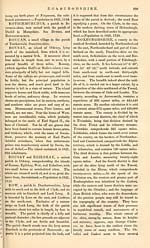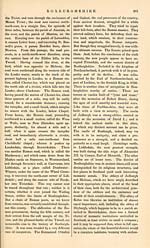Gazetteer of Scotland > Volume 2
(420) Page 900
Download files
Complete book:
Individual page:
Thumbnail gallery: Grid view | List view

900
ROXBURGHSHIRE.
many hills by artificial aids. The great
peninsula, which is formed by the Tiviot
and the Tweed, was once full of military
works. The Eildon hills are finely form-
ed for strengths of this description. The
most northerly, which is also the loftiest
of these hills, was fortified by two fosses
and ramparts of earth, enclosing a circum-
ference of more than a mile. This great
fort of the Gadeni was the commodious
centre of other British forts, on the sum-
mits of the smaller eminences of the sin-
rounding country. In after times, the Ro-
mans are supposed to have converted this great
native fortress into a commanding post, near
their military road. About two miles west
from the Eildons, rises Caldshiels hill, whereon
the Gadeni had a considerable strength. It
may be noticed that betwixt these two eminent
British hill forts there was a fosse or ditch,
and its accompanying rampart of earth. This
immense work has much the appearance of the
Catrail, and was doubtless erected with the
similar view of defending the country from an
invasion by the east. But the most stupen-
dous work of the Britons is the Catrail, just
alluded to. This is probably the vast remain
of the Romanized Britons, the descendants of
the Gadeni and Ottadini after the abdication
of the Roman power ; and it seems to have
been constructed during the fifth century, as a
strong line of defence against the invading
Saxons. After traversing Selkirkshire, this
rude barrier enters Roxburghshire, where it
crosses the Borthwick water, near Broadlee :
Here its remains are very visible ; and it con-
tinues to be equally distinct till it reaches
Slatehill moss ; whence it runs in a south-east
direction, across the Tiviot, through the farm
of Northhouse, to Dogcleugh-hill, where it ap-
pears very obvious to the eye. From this
position, it proceeds south-east, in a slanting
direction, across Allan water to Dod ; pass-
ing, in its course, two hill forts on the left.
From Dod, the Catrail courses eastward,
near another British fort, on Whitehill brae;
and it now ascends the Carriagehill, where-
on it appears very prominent. From this
height, it descends across Longside burn,
where it becomes the known boundary of
several estates. From this burn it tra-
verses the northern base of the Maidenpaps
to the Leapsteel ; and thence holding its
forward course by Robertslin, and Cock-
spart, it crosses the dividing hills into Lid-
disdale ; and again appears on the Daw-
stane burn, where the Scottish Adian was
defeated in 603 A. D. by the Saxon powers.
Its vestiges may thence be traced nearly to the
Peelfell, on the confines of Liddisdak, where
this district bounds with Northumberland.
From its remains, the Catrail appears to have
been a vast fosse, at least twenty-six feet broad;
having a rampart on either side of it, from eight
to ten feet high, which was formed of the
earth that was thrown from the ditch. The
whole course of the Catrail, from the vicinity
of Galashiels, in Selkirkshire, to Peelfell, on
the borders of Northumberland, is upwards of
forty-five miles, whereof eighteen of its course
are within Roxburghshire. Catrail means, in
the language of the constructors of it, the di-
viding fence, or the partition of defence ; Cad, in
the British speech, signifying a striving to
keep, a conflict, a battle ; and Rhail mean-
ing, in the same language, a division. From
this singular remain of the Britons, within the
shire, which has engaged nearly as much at-
tention from the antiquary as the wall of An-
toninus, it is natural to advert to the Roman
road which traversed Roxburghshire, from the
south to the north. George Chalmers de-
scribes its course with his usual accuracy.
This Roman way is a continuation of the Wat-
ling Street, or the Middle Roman road into
North Britain. The Watling Street, after
crossing the walls of Hadrian, and of Severus,
at Port-gate, and passing the stations of
Risingham, and Rochester, arrives at Chew-
green, the nearest station to the borders.
It now touches Roxburghshire, at Brown-
hart-law ; whence passing along the moun-
tains, it forms the boundary of the two
kingdoms, for a mile and a half, till it arrives
at BJackhall, where it enters Scotland ; and,
descending the hills, it crosses the Kail water,
at Twoford ; where, passing a hamlet, which
is named from it Street house, the road runs
several miles between Hownam parish on tha
east, and Oxnam parish on the west, till it
arrives at the south-eastern corner of Jedburgh
parish. From this position, the road pushes]
forward north-westward, in a straight line 5
passing the Oxnam water a little below Cope-
hope, and the Jed, below Bonjedworth. Hav-v
ing now traversed the neck of land betweertj
the Jed and the Tiviot, where some vestiges*
of a station have been observed, it crosses
ROXBURGHSHIRE.
many hills by artificial aids. The great
peninsula, which is formed by the Tiviot
and the Tweed, was once full of military
works. The Eildon hills are finely form-
ed for strengths of this description. The
most northerly, which is also the loftiest
of these hills, was fortified by two fosses
and ramparts of earth, enclosing a circum-
ference of more than a mile. This great
fort of the Gadeni was the commodious
centre of other British forts, on the sum-
mits of the smaller eminences of the sin-
rounding country. In after times, the Ro-
mans are supposed to have converted this great
native fortress into a commanding post, near
their military road. About two miles west
from the Eildons, rises Caldshiels hill, whereon
the Gadeni had a considerable strength. It
may be noticed that betwixt these two eminent
British hill forts there was a fosse or ditch,
and its accompanying rampart of earth. This
immense work has much the appearance of the
Catrail, and was doubtless erected with the
similar view of defending the country from an
invasion by the east. But the most stupen-
dous work of the Britons is the Catrail, just
alluded to. This is probably the vast remain
of the Romanized Britons, the descendants of
the Gadeni and Ottadini after the abdication
of the Roman power ; and it seems to have
been constructed during the fifth century, as a
strong line of defence against the invading
Saxons. After traversing Selkirkshire, this
rude barrier enters Roxburghshire, where it
crosses the Borthwick water, near Broadlee :
Here its remains are very visible ; and it con-
tinues to be equally distinct till it reaches
Slatehill moss ; whence it runs in a south-east
direction, across the Tiviot, through the farm
of Northhouse, to Dogcleugh-hill, where it ap-
pears very obvious to the eye. From this
position, it proceeds south-east, in a slanting
direction, across Allan water to Dod ; pass-
ing, in its course, two hill forts on the left.
From Dod, the Catrail courses eastward,
near another British fort, on Whitehill brae;
and it now ascends the Carriagehill, where-
on it appears very prominent. From this
height, it descends across Longside burn,
where it becomes the known boundary of
several estates. From this burn it tra-
verses the northern base of the Maidenpaps
to the Leapsteel ; and thence holding its
forward course by Robertslin, and Cock-
spart, it crosses the dividing hills into Lid-
disdale ; and again appears on the Daw-
stane burn, where the Scottish Adian was
defeated in 603 A. D. by the Saxon powers.
Its vestiges may thence be traced nearly to the
Peelfell, on the confines of Liddisdak, where
this district bounds with Northumberland.
From its remains, the Catrail appears to have
been a vast fosse, at least twenty-six feet broad;
having a rampart on either side of it, from eight
to ten feet high, which was formed of the
earth that was thrown from the ditch. The
whole course of the Catrail, from the vicinity
of Galashiels, in Selkirkshire, to Peelfell, on
the borders of Northumberland, is upwards of
forty-five miles, whereof eighteen of its course
are within Roxburghshire. Catrail means, in
the language of the constructors of it, the di-
viding fence, or the partition of defence ; Cad, in
the British speech, signifying a striving to
keep, a conflict, a battle ; and Rhail mean-
ing, in the same language, a division. From
this singular remain of the Britons, within the
shire, which has engaged nearly as much at-
tention from the antiquary as the wall of An-
toninus, it is natural to advert to the Roman
road which traversed Roxburghshire, from the
south to the north. George Chalmers de-
scribes its course with his usual accuracy.
This Roman way is a continuation of the Wat-
ling Street, or the Middle Roman road into
North Britain. The Watling Street, after
crossing the walls of Hadrian, and of Severus,
at Port-gate, and passing the stations of
Risingham, and Rochester, arrives at Chew-
green, the nearest station to the borders.
It now touches Roxburghshire, at Brown-
hart-law ; whence passing along the moun-
tains, it forms the boundary of the two
kingdoms, for a mile and a half, till it arrives
at BJackhall, where it enters Scotland ; and,
descending the hills, it crosses the Kail water,
at Twoford ; where, passing a hamlet, which
is named from it Street house, the road runs
several miles between Hownam parish on tha
east, and Oxnam parish on the west, till it
arrives at the south-eastern corner of Jedburgh
parish. From this position, the road pushes]
forward north-westward, in a straight line 5
passing the Oxnam water a little below Cope-
hope, and the Jed, below Bonjedworth. Hav-v
ing now traversed the neck of land betweertj
the Jed and the Tiviot, where some vestiges*
of a station have been observed, it crosses
Set display mode to: Large image | Transcription
Images and transcriptions on this page, including medium image downloads, may be used under the Creative Commons Attribution 4.0 International Licence unless otherwise stated. ![]()
| Gazetteers of Scotland, 1803-1901 > Gazetteer of Scotland > Volume 2 > (420) Page 900 |
|---|
| Permanent URL | https://digital.nls.uk/97435862 |
|---|
| Description | Volume II: Glenbanchor to Zetland. |
|---|---|
| Attribution and copyright: |
|
| Description | By Robert Chambers and William Chambers. Glasgow: Blackie & Son, 1838. 2 volumes. |
|---|---|
| Shelfmark | NF.1461.g.7 |
| Additional NLS resources: | |

